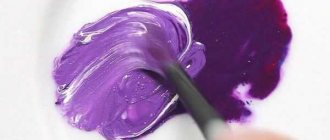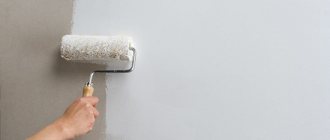As you know, even the most reliable coating begins to deteriorate or change color over time, but, as a rule, most often this or that design simply becomes boring or does not fit with new furniture or flooring. Some people undertake a full-scale renovation, but everything can be done much easier and faster.
In this article we will look at how to repaint the walls and thereby transform the room.
You are quite capable of carrying out painting work without the involvement of specialists
Primer...good idea!
Proper preparation is the basis. Even the best coatings and the most expensive paints will not pass the test if the wall surface is not cleaned of stains, mildew and mold. Before painting, it is necessary to remove contaminants and remove irregularities that could cause cracking of the new layer. They can disrupt the smooth structure or contribute to the formation of streaks and gaps. It is also important to fill cavities, cracks and holes in the walls by polishing them and removing dust.
Preparation will also require the use of a primer paint or primer, such as latex primer emulsion. The role of the product is to level out the absorbency, homogenize the substrate, as well as improve adhesion and reduce paint consumption. The effect of this will not so much reduce repair costs as it will reduce operating time. In this case, the expected result can be achieved after applying the first layer of the new color.
How to apply primer? It is better to start from corners and hard-to-reach places. To do this, use a small brush or a paint roller with a width of 10 to 15 cm. Then, moving at right angles, we move to larger surfaces with a roller up to 25 cm wide.
Technology
A layer of primer is applied to the surface prepared for repainting , which creates an invisible film and is especially important in cases of strong changes in color. The primer mixture is applied in an even layer at a consumption of approximately 100 grams per m2 and smudges of the composition are immediately removed, since its base is glue and it will be difficult to remove it from the floor after setting.
The pigment is added to neutral-colored paint and mixed using a mixer, making sure that it is clean, otherwise the finished composition will have to be filtered. It is important to choose the right roller for repainting, since corrugated wallpaper requires a medium-pile tool, while a smooth surface can be treated with a foam roller or velor tool.
A telescopic rod for a roller will not be superfluous in the work, however, if you have not used it before, it will not speed up the process, but a bath for paint is necessary. First, use a brush to trim hard-to-reach areas, after which you can roll the entire wall, applying the first layer in any direction, and the second in the direction of the light. The interval between applying layers of acrylic paint should be at least 4 hours at a humidity of up to 60% and a temperature of 20 degrees. Remember that the paint dries darker , because when the water evaporates, the concentration of the dye increases, so do not make the color too dark, at least for the first layer.
You should always dilute acrylic paints with a reserve, since you may have to repaint the walls not in two, but in three layers (depending on the degree of color change) and remember the saying “the reserve does not last your pocket,” but you can find out about the approximate consumption of acrylic paint here.
If you are planning to repaint the walls in a different color yourself, then carefully prepare for the finishing and take your time in the process - this will guarantee a successful job, and we also suggest that you familiarize yourself with how to repaint the ceiling if your neighbors presented you with a “surprise”.
Questions and answers
Is it necessary to prime the walls?
A primer is considered mandatory if you dramatically change the contrast of the color of the walls, for example, blue to light green. In any case, priming will not hurt and will not take much time, so it is better to prime than not. A primer is also necessary if you want to remove greasy stains on wallpaper, but first you need to go over the stain with a detergent.
Does the direction of movement of the roller matter when repainting?
It doesn’t matter that they don’t say “docks” there. As a rule, the direction of movement of the roller is important when applying the second layer when painting the ceiling, since the light falls on it better - one and the plane is completely open - two. On the walls, when painting them with acrylic, there will be no streaks depending on the direction of movement of the roller, but the paint must be rolled out carefully.
Source
Paint selection criteria
Choose thick paint, especially if you take on the task of painting a dark wall snow-white.
On store shelves there are products with different levels of coverage - from high to low, with lower or higher costs. Price in this case should not be a factor determining the choice, because often the cheaper paint is the least economical. It will require the application of several additional layers and, thus, will require more time and the repair will be delayed. This also doesn't mean you have to find the most expensive paint. The most important criterion is quality! To choose the right paint, it is best to analyze the information on the label.
The label contains detailed information about its purpose, type of substrate, coating. It indicates the drying time and productivity, which determine the size of the surface that can be painted over with one liter of product. In addition to them, it is worth paying attention to whether the paint has expired. This can greatly limit its effectiveness. It is also worth familiarizing yourself with the manufacturer's recommendations, for example regarding paint thinning. If they are not there, do not experiment and do not look for savings, because the effect may be counterproductive.
Pros and cons of painted walls
Painting the walls can be a good option for decorating a room. However, in order to make the right decision, it is worth understanding the positive and negative aspects of the process. The following advantages of painting walls can be highlighted:
- The preparatory stage before painting the surface allows you to obtain an improved appearance of the surface, which thanks to this will last longer;
- Correcting the old coating, if paint was used, will be easy; quick touch-up of damaged areas is possible;
- The painted surface can be washed, this helps to easily get rid of stains that may appear over time;
- The paint does not attract the attention of pets, for this reason there is no need to worry about the integrity of the material;
- There are a large number of types of paints that help you choose the right option for your intended design;
- There are many colors of colorful products, which also makes it easy to select the required shade;
- There are textured types of paints that help imitate expensive types of finishes and look presentable;
- Acceptable cost of work.
There are a large number of types of paints that help you choose the right option for your intended design.
Despite the large number of advantages, painting the walls in an apartment also has disadvantages, without knowledge of which you should not make a final decision:
- To get an even coating, you will have to properly prepare the surface; the paint highlights any flaws; the process is often difficult for beginners, although, of course, such preparation is useful for housing;
- The paint and varnish material can be washed, but it tends to attract dust, requiring frequent maintenance;
- The resistance to mechanical damage of dyes is not at the highest level;
- High-quality paint and varnish material can be expensive, and you won’t be able to save money.
To get an even coating, you will have to properly prepare the surface.
Tools
White walls are not just a matter of proper preparation and a good coat of paint. Roller tools make a big difference too! The most versatile are those with medium bristles (suitable for painting mineral plasters and structural wallpaper). However, if you need to paint rougher surfaces of concrete, brick or structural plaster, it is better to use a roller with long bristles. This will allow you to cover the uneven surface tightly without gaps.
The material from which the roller is made is no less important. Here the choice should depend on the type of paint used. Waterborne paints are best applied using microfiber rollers. Oil paints are usually applied using wool, acrylic or velor, latex and dispersion, string, and sponges. You need a ditch to apply the paint evenly. A film that will protect furniture and floors from dirt and masking tape.
The main question: how to paint? The first step is to prepare the video. If it is new, it should be moistened and excess water squeezed out. It is also worth removing loose bristles using self-adhesive tape. They can leave unsightly marks.
Start by painting the ceiling (if the room has a window, work from the frame to the inside), then move on to the corners and walls. At the very end, the surface should be smoothed by moving the roller from top to bottom. This will avoid streaks and stains and thus ensure a perfectly painted wall.
Preparing the wall surface
Preparation is an important step before painting. It is necessary to remove the old coating to obtain a better degree of adhesion. The surface is cleaned of all types of dirt and degreased. Then it is primed; if necessary, defects are covered with putty to obtain an even coating.
It is necessary to remove the old coating to obtain a better degree of adhesion.
Patience pays off
Painting—no matter the color you choose—is a lesson in patience. It is not recommended to rush, because it can ruin everything. You don't want to redo everything, do you? The key to effective performance is to follow the drying time indicated on the label. This applies not only to the first coat of paint, but also to primers. Factors that can speed up this process slightly are optimal conditions, that is, a temperature between 10 ° C and 25 °. C and well ventilated room.
After years of dominance by greys, browns and soft greens, white is making a comeback. Walls in such a universal color decorate the room, visually enhance the interior and fit into any style. Therefore, more and more people are ready to use white in their interior. As it turns out, repainting a darker surface a lighter shade isn't that tedious. Good tools, quality paint and a little patience are enough to achieve results.
Paintable wallpaper is the best option for those who want to make their interior unique. Their essence is quite simple: a clean canvas sets the relief, and paint sets the color. This solution is beneficial for those who are tired of seeing colorful drawings on the walls, wasting time on joining them, or simply want to use the canvas as a canvas for drawing. The article tells you which canvases can be painted and what you will need for this.
What kind of canvases can be painted?
Coatings with special impregnation were invented. They make the canvas stronger, and by partially absorbing the coloring pigment, they securely fix the strip to the surface.
The base can consist of any material, but three types of wallpaper are most often used:
- Paper. A thick layer of cellulose fiber impregnated with a primer. The material is durable and will hide some unevenness in the walls. The rolls are quite cheap and easy to handle.
- Non-woven. Non-woven material is a non-woven material made from small compressed, usually synthetic fibers. The surface of the canvas is additionally treated with foamed vinyl, which gives the material a given texture.
- Glass wallpaper. This is a composite material - an interweaving of glass and paper threads. quite expensive canvas, has many advantages. Glass wallpaper hides wall defects well, is non-flammable, and can serve as an additional moisture and vapor barrier. They can often be found in public places due to their increased wear resistance.
What will you need?
To decorate a wall with wallpaper for painting, you need several things:
- Floor protection material. Gluing, like repairs, is a dirty task. If there is an expensive laminate or any other covering on the floor that you would not want to damage with wallpaper glue or dust, you should buy plastic film (how to choose wallpaper for laminate?). It is easy to spread, and after repairs, roll it up and put it away along with construction waste.
- Masking tape is useful for protecting baseboards. It can be used to mark areas for painting.
- Primer. Sometimes the primer with which the canvas is impregnated may not be enough. Then the paint will reach the wallpaper glue and dissolve it. All your efforts will go down the drain. It is better to pre-treat the pasted wall.
- Paint that matches the type of wallpaper. For glass wallpaper, alkyd is usually used. They leave a thin protective film on the surface that will protect the coating from mechanical damage. After drying, it can be washed (how to clean wallpaper from dirt?).
- For non-woven and paper - water-emulsion, latex. It will not allow the fabric to get wet and will create a reliable barrier against fungi and mold, as it will not allow moisture to pass through.
- Brushes, rollers. A set of thin brushes can be very useful for painting corners and areas near baseboards. Rollers are suitable for large surfaces. If the wallpaper materials are smooth, then it is better to choose a roller with short pile. If embossed - with a long one.
Features of painting walls of different materials
To get the desired result after painting, work must be performed taking into account the characteristics of the base. After all, each material requires compliance with a number of nuances.
To get the desired result after painting, work must be performed taking into account the characteristics of the base.
Wooden walls
Step-by-step instructions for working with wood include the mandatory application of a primer. The paint should be selected with good vapor permeability.
The paint should be selected with good vapor permeability.
Brick walls
Cleaning the surface with water is carried out seven days before painting. The walls are primed. Brickwork can be painted with acrylic and alkyd paints.
Brickwork can be painted with acrylic and alkyd paints.
Concrete walls
Concrete will absorb all the paint if it is not treated with a deep penetration primer solution. Latex and epoxy paints are suitable.
Concrete will absorb all the paint if it is not treated with a deep penetration primer solution.
Wallpaper
Painting over wallpaper makes it possible to repaint it at any time. For this purpose, a water-based type of paint is chosen; the water base eliminates the presence of thinners.
Painting over wallpaper makes it possible to repaint it at any time.
Drywall
Drywall is a material onto which a putty, plaster and primer solution is applied before painting. Products based on acrylic and silicone can be selected.
Drywall is a material onto which a putty, plaster and primer solution is applied before painting.
Plaster
It is necessary to create a perfectly level surface and remove all minor flaws. Two coats will be required to cover the porous structure.
It is necessary to create a perfectly level surface and remove all minor flaws.
How to carry out the procedure correctly?
One of the advantages of paintable wallpaper is that it can be repainted from time to time. At least that's what most consumers think. But many who tried to do this were very disappointed with the result. In what cases is this idea good, and when is it better to just re-glue new ones?
Evaluate how well the coatings adhere to the wall. If they have already started to show noticeable bubbles and have sagged in some places, then an additional layer of wet paint will make the canvas heavier and make it completely peel off (how to remove bubbles on wallpaper and what to do if the coating peels off?).
If they hold up well, you can start painting. There are several rules.
- First, according to the relief: the finer it is, the greater the chances of painting it over.
- The second is the cleanliness of the paintings. The less dust on them, the better the paint will adhere. To clean the wall, you can use a vacuum cleaner or simply walk over it with a damp cloth. The surface must be completely dry.
- If the color is not too saturated or the previous color is still striking, you should wait until the painted canvases are completely dry, and only then try to paint them again, with a second layer.
If you need to replace dark colors with light ones
High-quality paintable coatings can be repainted many times. What if the next layer should be lighter than the previous one?
Many people who have tried to apply a coat of light paint over existing dark paint have complained that it takes more than five coats to completely change the color. It takes a lot of money, paint and effort.
If you don’t want to re-glue, but you need to change the tone from dark to light, you need to put another one on top of the main layer. Absolutely white. It will act as a primer and help you quickly change color. One or two layers of a new color are enough to completely change the color of the wall.
Expert tips for painting walls with your own hands
To make painting easier, you need to pay special attention to surface preparation. In this case, if the wall requires leveling, you can resort to the services of craftsmen. When choosing a coloring agent, the type of base is taken into account; carrying out the work also requires knowledge of the intricacies of working with different materials, they were described earlier.
To make painting easier, you need to pay special attention to surface preparation.
Painting the surface is a quick and easy option to update the interior of a room. The construction market offers a huge number of different types of coatings. If desired, you can create not only a smooth coating, but also a textured one. It is important to follow the instructions to get the desired result.
How many times is it acceptable to do this?
Each painting case is individual, and the quality may depend on the condition of the coatings, walls, room humidity, etc. Factors influencing the number of re-paintings:
- Relief. The more prominent the relief pattern is on the wallpaper, the more difficult it is to paint over it over time. A weak relief pattern may be painted over after the third or fourth time.
- Paint viscosity. The more viscous it is, the thicker the film it will create on the surface. If you overdo it, then, firstly, the wallpaper will become very heavy and may peel off, and secondly, the textured pattern will become more and more blurry and fuzzy with each painting.
- Brush or roller bristles. The shorter it is, the denser the paint will be, the smoother the painted wall will be. If you try to paint a wall with a short-nap roller several times, the design on it will soon disappear. Buying embossed materials for painting will no longer make sense.
Design options
Before painting a room, you should think about the overall color scheme and design. Depending on the idea and the overall tone of the interior, you can paint a wall in different ways.
- Single color paint. The most common, simple and fast option, suitable for discreet and austere interiors.
- Painting in several tones. Here you can already show your imagination. You can paint each wall a separate color; sometimes it is necessary to highlight a niche with color, create a frame under the head of a bed or a false fireplace, etc. Colors can be alternated on one wall, creating stripes, diamonds, or applying paint in several layers using stencils.
- Uneven paint application. This method is especially appreciated in grunge or loft style interiors. The paint is applied with sharp strokes, sometimes diluted with a solvent to create an uneven texture and smudges.
- Craquelure effect. Created with a special varnish. Applied on top of the main background, it causes the paint to crack openly. Adds a slight antique effect, emphasizing the sophistication of the room.
- Gradient. If you paint the wall with two different shades, and then, even before the paint dries, start mixing it carefully (at the junction of colors) with a dry roller, you can get a very smooth, beautiful transition.











